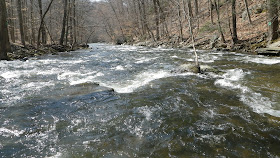As promised, here is a little more information on the this "new" pattern. Last fall I started playing around with a few small dark colored generic nymph imitations. Using Fly DK synthetic quill material as a abdomen allowed for a neat trim profile. A little silver wire for ribbing, synthetic peacock dubbed thorax for a buggy apperance, a strip of mylar for the wing case adds a little flash and a black tungsten bead to supply the weight and the Little Dark was born. This pattern has quite a bit of flash to it. The Fly DK Pearl synthetic quill abdomen gives it iridescence and the silver wire and mylar wing case add quite a bit of sparkle.
The first two trips of the year as yielded excellent results for this new pattern. The river at the time was seeing a lot of small black stone fly activity which may have accounted for its success. I will have to see if it continues to produce through out the year.
Recipe:
Hook: 2xlong nymph hook size 14-18
Bead: Black tungsten
Thread: Black 6/0 Danville
Tail: Dyed black pheasant tail fibers
Ribbing: Small silver wire
Abdomen: Fly DK Pearl Synthetic Quill
Thorax: Synthetic peacock dubbing
Wing case: Mylar
If you need a source for the DK synthetic quill check out Performance Flies. Kevin is a great guy to deal with and has always been my source for this fantastic fly tying material.























